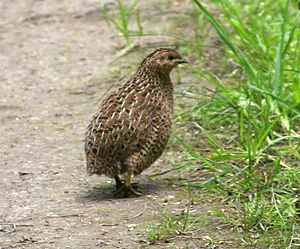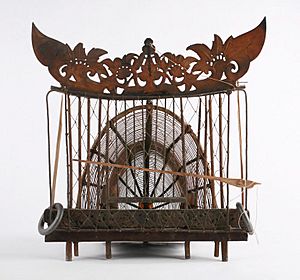Old World quail facts for kids
Quick facts for kids Quail |
|
|---|---|
 |
|
| Brown quail, Coturnix ypsilophora | |
| Scientific classification | |
| Kingdom: | |
| Phylum: | |
| Class: | |
| Order: | |
| Family: |
Horsfield, 1821
|

Old World quail are a group of small, plump birds that belong to the pheasant family, called Phasianidae. They are often found walking on the ground.
It's important to know that there are other birds called "quail" that are not in the same family. For example, New World quail live in a different family called Odontophoridae. Also, Buttonquails look similar but are not closely related at all. They are part of the Turnicidae family, which is more like shorebirds or gulls.
When you see a group of quail together, you can call them a flock, a bevy, or a covey.
Different Kinds of Quail
Scientists group living things into categories to understand them better. This is called taxonomy. Old World quail include several different types, or species, that are part of the Phasianidae family. Here are some of them:
- Genus Coturnix
- Common quail, Coturnix coturnix
- Japanese quail, Coturnix japonica
- Stubble quail, Coturnix pectoralis
- †New Zealand quail, Coturnix novaezelandiae (This species is now extinct)
- Rain quail, Coturnix coromandelica
- Harlequin quail, Coturnix delegorguei
- †Canary Islands quail, Coturnix gomerae (This species is only known from fossils)
- Brown quail, Coturnix ypsilophora
- Blue quail, Coturnix adansonii
- King quail, Coturnix chinensis
- Genus Anurophasis
- Snow Mountain quail, Anurophasis monorthonyx
- Genus Perdicula
- Jungle bush quail, Perdicula asiatica
- Rock bush quail, Perdicula argoondah
- Painted bush quail, Perdicula erythrorhyncha
- Manipur bush quail, Perdicula manipurensis
- Genus Ophrysia
- Himalayan quail, Ophrysia superciliosa (This species is critically endangered, meaning it's very close to extinction, or might already be extinct)
Quail Behavior and Habits
Old World quail are small, plump birds that live on the ground. They mostly eat seeds, but they also like to snack on insects and other tiny creatures.
These birds build their nests on the ground. Even though they spend a lot of time walking, they can fly in short, very fast bursts when they need to escape danger. Some types of quail, like the Japanese and common quail, are migratory. This means they fly long distances to different places during certain seasons.
Many quail are raised on farms. The common and Japanese quail are often raised for their meat or to produce eggs. People also enjoy hunting quail. Sometimes, quail are even released from farms to add to the wild populations for hunting.
An Interesting Fact About Quail
Migrating common quail can sometimes eat certain poisonous seeds without getting sick themselves. However, they store these natural poisons in their body fat. If a person then eats these particular quail, they might get sick. This condition is known as "coturnism".

